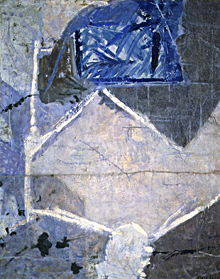1b
ヴェネツィア・ビエンナーレへの参加
Participating in La Biennale di Venezia
【本文確定】
1951年、サンフランシスコ講和条約と日米安全保障条約の調印によって、日本は西側世界への国際社会復帰を果たしました。そしてその翌1952年、ヴェネツィア・ビエンナーレに初めて正式に参加しました。しかしその参加は、戦後に復活した戦前の美術界の制度が、世界の実状にまったく見合っていなかったことを露呈したのです。戦前の制度とは、近代以前の自国の伝統的美意識を現代に継承する「日本画」という分野と、西洋出自の近代絵画を日本的に受容する「洋画」という分野の共存、さらには「洋画」内部での新旧抗争を代弁する官展と在野団体の共存のことです。ヴェネツィアには、それぞれの分野を代表する全11名の作品が年功序列式に送られました*1b1。
はたして、数十年前に活躍した大勢の老巨匠の作品を数点ずつ取りそろえたところで、日本の展示全体として説得力のある主張ができたわけではありません。他国はといえば、最も有力な新人数名のみを、明快な展示コンセプトのもと、国家の威信をかけて売りこんでいたのです。国際展の場で全く無視されたという反省をふまえ、二回目の参加からはさまざまな試行錯誤がなされるようになりました。初期の話題としては、1956年の日本館竣工と棟方志功の版画グランプリ受賞、1958年の岡田謙三の受賞が挙げられます。
ちなみに、アメリカの抽象表現主義の様式に幽玄という日本的感覚を注入し「ユーゲニズム」と呼ばれた岡田謙三の場合、西洋人たちの東洋趣味(オリエンタリズム)への迎合だとか、アメリカ様式の日本へのローカリゼーションにすぎないといった批判がありえます。しかし明治時代(1868-1912年)以降の日本の近代が西洋文明に対する憧憬と、そこから反転された自国文化への執着として始まっている以上、彼の作品にはどの日本人画家にも共通する問題が典型的に顕れているとも考えられます。もちろん洋画と日本画という制度の二重性も、同じ問題の顕れです*1b2。
In 1951 Japan signed the San Francisco Peace Treaty and the Security Treaty Between The United States and Japan, coming back to the international scene though limited to the West. And in the following 1952 Japan officially participated in La Biennale di Venezia for the first time, which exposed that the prewar system of Japanese art world was reestablished after the war just to find itself totally uncompetitive with the international one. The prewar system here is meant to be the co-existence of two genres "Japanese-style painting (Nihonga)" and "Western-style painting (Yoga)," of which the former aims to conserve the pre-modern Japanese aesthetic to modern times, while the latter strives to comprehend Western modern paintings in a Japanese way. Adding to these representing the domestic and the oversea within Japan, the system also included the co-existence of exhibitions run by the governmental and non-governmental organizations, reflecting the internal strife between the old and the new within Japanese "Western-style painting." For the Biennale, works of eleven artists were selected according to their seniority and shown at Venice to stand for each genre respectively*1b1.
However, no matter how gathering several pieces respectively from old masters whose peak had already passed a few decades ago, participation in the Biennale was hardly successful in claiming anything particularly Japan impressively. Other countries, on the contrary, succeeded in promoting their national prestige by exhibiting only a few young innovative artists with clear-cut concepts. Having experienced ignorance from the international arena, Japan started a series of try and error to overcome the failure from the second participation on. To introduce some other topics from this early period, completion of Japanese Pavilion and the artist MUNAKATA Shiko (棟方志功)'s grand-prix at printing in 1956, or the painter OKADA Kenzo (岡田謙三)'s winning the prize in 1958 were remarkable.
As a side note, the style of OKADA Kenzo (岡田謙三) came to be called "Yugenism" abroad for its introducing Japanese sensibility called Yugen into the style of American abstract expressionism, potentially subject to criticism that designates it nothing more than obeying Westerners' Orientalism or localizing the style of art in the USA. Still, ever since Japanese modernism from the Meiji period (1868-1912) was originated in combination of adoration for Western civilizations and adherence to domestic culture as its reversal, the twisted nationality in his work can be considered as representing the common issues that no Japanese painter can escape. Analogously, the duality of "Western-style painting" and "Japanese-style painting" within the art system in Japan derives from the same roots*1b2.

